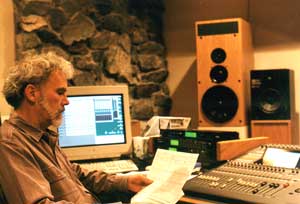|

more
about Bill McElroy, Soundsmith
|
Full Service
Mastering & Editing
For Mastering and editing tasks,
Slipped DISC features Sonic Studio, USP 16/32 from Sonic
Solutions, with accuracy to 24-bit, one of the finest high-powered
digital editing and mastering system available. Editing
of up to 32 panels may be mixed or output through 16 simultaneous
channels, with EQ, Dynamics and automated mixing available.
Mastering sources may be CD, DAT, 24bit DAT or Analog Tape.
|
| Mastering:
The Last Stand or Final Frontier?
In the early days of direct-to-disc
recording, mastering was such an integral part of the recording
process that it was not recognized with a separate name.
With the advent of magnetic tape and, importantly, the ability
to edit, material recorded at different times could be placed
together on master reels, and sent off for mastering at
a record plant. This process was typically a black-box engineering
process to get the audio from the master tape onto the master
lacquer disc for vinyl record production. A good mastering
engineer was the person who could make the record sound
as good as the tape. Mastering was considered a technical,
rather than an artistic process, somewhat similar to the
chemical plating processes used to make record stampers
from the master lacquers.
As phonographs progressed from record
players to stereos to entertainment centers, and as listeners
became audiophiles, the need to balance songs against each
other and make even more final touches grew. Producers,
artists and engineers, not wanting to endure the sound degradation
of an additional tape generations, found that mastering
was yet one more place that sound could be altered, manipulated
and shaped while the transfer to lacquer was taking place.
Thus, mastering came into its own as an art form. Though
vinyl is no longer the mainstream media of choice, mastering
is, today, considered to be an important step in the artistic
presentation of any project.
Electronic evolution has made it possible
to make digital transfers or copies with apparently no degradation.
These final "tweaks" can be made to a new master
file, tape or disc. No longer do changes have to be made
"on the fly" while the master is being created.
It is possible, however, to abuse this newfound freedom.
The old phrase "we'll fix it in the mix" has been
digitally re-mastered and re-released as "we'll fix
it when we master". Although much can be done to enhance
a mixed piece of music, the best time to raise or lower
the vocal level or a harmony part or that searing sax solo,
is still back at the mixing session.
So, if mixing is the process
of bringing all the elements of a song together, then one
can view mastering as bringing all the songs together. This
is the easiest and simplest place to: change the order of
the songs, change the spacing between the songs, put two
or more pieces together to have the songs "crossfade"
from one to another, and to make those final tonal or dynamic
changes in the sound of each song. All of these factors
fit together to make the final product sound like "a
commercially available product".
|

